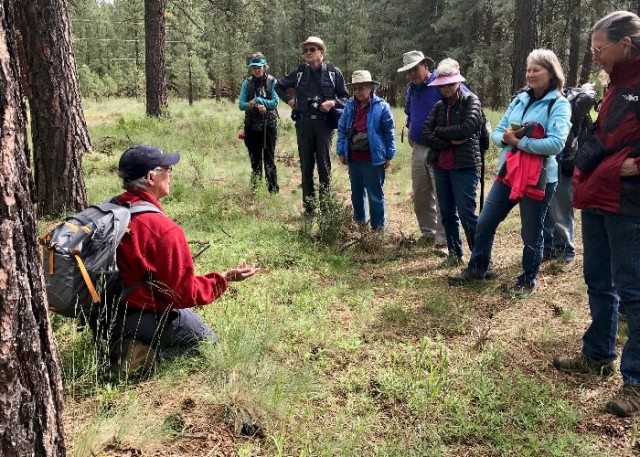Northwest Travel: Washington County rocks
Published 12:00 am Sunday, March 15, 2015

- Kyanite crystals, Brazil
HILLSBORO —
There are few more stunning sights in Oregon than the Rainbow Gallery of fluorescent minerals at the Rice Northwest Museum of Rocks and Minerals.
Trending
Step behind a blackout curtain to see otherwise colorless rocks explode into brilliant colors — emerald green, cobalt blue, fiery red, yellow, orange, pink, purple — when they are bathed in ultraviolet or “black” light.
Colors emerge as short-wave and long-wave fluorescence flows upon the rocks, activating impurities within them. Specimens of more than 500 types of minerals, about one in every seven, are known to fluoresce. They come from every continent and in virtually every color of the rainbow. {%TravWashCo-p03 031515%}
There are calcites — orange, red, pink, even bright blue. Willemite and autunite may be yellow-green; scapolite shows up as orange-yellow; dolomite is often a vivid orange, and hardystonite may appear as deep blue, almost violet. Fluorescent colors are ascribed to aragonite, clinohedrite, eucryptite, rhyolite, scheelite, termolite and other minerals that the average person may only read about in a dictionary.
They may all be seen in the Rice Northwest Museum of Rocks and Minerals, considered one of the finest geology museums in the United States. Recently approved as one of only three Smithsonian Institute affiliates in Oregon (the others are in McMinnville and Ashland), it has unparalleled collections of Northwest minerals and petrified wood, along with several iconic, one-of-a-kind specimens.
Although it is located just off U.S. Highway 26 west of Portland, the museum is virtually unknown outside of rockhounding circles. “This is a different part of nature, not what people typically think of when they hear that word,” explained executive director Julian Gray. “We preserve the rare and beautiful ‘things’ of nature.” {%TravWashCo-p02 031515%}
A passion for rocks
Trending
Oregon’s Washington County, which embraces the Tualatin River Valley, is far from unknown to business travelers. Home to technology company Intel and numerous other high-tech firms, along with footwear and clothing giant Nike, it is a destination for visitors from around the world.
That includes Central Oregonians, of course. But all work and no play makes Jack a dull boy. Curious about after-work activities and dining options in Hillsboro, Beaverton and nearby communities, I wandered between these towns and others — within a half hour’s drive southwest of downtown Portland when rush-hour traffic doesn’t interfere — on a recent three-day visit.
My most memorable discovery was the Rice Northwest Museum, open weekends and Wednesday through Friday afternoons.
Richard and Helen Rice were passionate rock collectors beginning in the 1930s, when they became enamored of agates they gathered on the Oregon coast. “Richard had money at a time when there were incredible minerals to be bought,” Gray explained. “He got involved in lapidary and learned to cut and polish his finds. But it began as a hobby.”
The couple built a ranch-style, flagstone home in 1953 and raised three daughters there. They displayed their specimens in lighted cases. As the family grew and moved away, the collection took over the house, and when the senior Rices moved out, their home became a private museum. It was accorded nonprofit status in 1996, a year before its founders’ deaths. {%TravWashCo-p01 031515%}
Now the museum is in its final transition phase from a family museum to a public institution. That will create many more fundraising opportunities — “Intel is a $57-billion company across the interstate, and we can’t approach them until we get this,” Gray quipped — with upgrades and possible expansion to follow. “With the addition of new technology, we want to become much more interactive, especially for school groups,” the director said.
Surrounded by 23 partially-wooded acres, the Rice house was the first ranch-style home to be placed on the National Register of Historic Places. Its galleries are both on the main floor and in the basement. One lower-level exhibit is the Dennis and Mary Murphy petrified-wood collection, displaying 460 specimens from all over the world, including more than a dozen from Central Oregon. There’s even a hokey “talking log” that speaks to young visitors.
A stunning collection of crystals is climaxed by the “Alma Rose,” an 18-inch-long rhodochrosite from Colorado’s Sweet Home Mine that may be the finest specimen of its type in the world. There are other exhibits of agates and meteorites, lapidary carvings and gem faceting. And in the adjacent Northwest Mineral Gallery building, museum curator Leslie Moclock will describe a zeolite, fossils and an opal-filled thunder egg considered to be the world’s largest. {%TravWashCo-p04 031515%}
Ethnic Asian cuisine
As a dedicated “foodie,” I also find Washington County remarkable for its wide variety of ethnic Asian restaurants — seemingly a greater concentration than in Portland itself. In a short visit, I enjoyed outstanding Indian, Korean and Japanese cuisine, and within a few more days, I might also have considered Chinese, Thai, Vietnamese, Persian and Lebanese.
A likely reason for this proliferation is the number of information technology specialists who have come from Asian countries to work in area corporations. In past visits, I have encountered many of them dining at Chennai Masala, and this time was no different.
The once-tiny cafe, however, had changed a lot in the two years since I last dropped in for a traditional meal of makhani dhal (lentils), saag paneer (spinach) and roti bread. Not only has expansion into an adjacent space more than doubled the size; the restaurant has also brightened its appearance with new furniture and decor. But the kitchen still dishes up the same marvelous spice blends of cardamom, cumin, coriander and garam masala that make the food of India unique. {%TravWashCo-p06 031515%}
In downtown Beaverton is a 1½-square-mile quadrant known to locals as “Little Korea.” It is home to at least 10 Korean restaurants that offer variations of grilled beef, pork belly, chicken and fish with fermented vegetables such as fiery-hot kimchee. I followed a recommendation to the Nak Won restaurant, and was stunned to be served an array of more than a half-dozen complimentary banchan (side dishes) before my meal arrived. They included a delicious variety of steamed and marinated vegetables and tofu. I would return just for this.
A longtime Tualatin Valley favorite has been Syun Izakaya, housed in a historic former library just off Main Street in quaint downtown Hillsboro. In true Japanese pub style, Syun offers a wide choice of sakes and beers, along with very fresh Oregon coast seafood at its sushi bar. Even more impressive is its selection of Japanese plates not often seen on this side of the Pacific — dishes like okonomiyaki (savory pancakes), agedashi tofu (bean curd in broth) and chawan mushi (steamed egg custard). For Japanophiles, it’s a real find. {%TravWashCo-p07 031515%}
For non-Asian food, I had an excellent dinner at the Italian-influenced Decarli Restaurant in the heart of Beaverton. Owned by husband-and-wife chefs with broad experience at such noted Portland restaurants as Fratelli, Saucebox and Bluehour, Decarli brings the big city to the suburbs. Cavatelli pasta with pork Bolognese, and beef short ribs braised in espresso and dried prunes and served with spaetzli, were outstanding.
Pinot noir culture
Washington County’s wine country embraces the North Willamette Valley. Many dozens of vineyards and wineries cover the hills that surround Hillsboro and Beaverton, as well as Sherwood, Gaston and Forest Grove. They are a great place for business travelers to sip and relax after a busy work week.
Probably no winery here deserves more acclaim than Ponzi Vineyards. It was founded in 1970 by Dick and Nancy Ponzi, who were among the first pioneers of Oregon’s pinot noir industry. They had earned national recognition for their wines before the end of that decade, helping to establish the region’s reputation.
After more than 40 years outside of Beaverton, the Ponzis built a new facility and opened it in June 2013. The historic estate still welcomes visitors, but the spectacular new tasting room and gravity-flow winery, looking north across the Tualatin Valley from a perch on Sherwood’s Mountain Home Road, invites more visitors these days. {%TravWashCo-p08 031515%}
And it’s all in the family: Dick Ponzi himself designed the four-level winery where younger daughter Luisa Ponzi holds forth as head winemaker, and son-in-law architect Brett Fogelstrom, husband of older daughter (and company president) Maria Ponzi, designed the adjacent tasting room, which nestles discreetly into the hills.
The winery is famous for its pinot noir production, but it also makes an Italian red varietal called dolcetto, and several whites — a citrusy pinot gris, a soft chardonnay, pinot blanc, Riesling and lesser-known arneis.
Other well-established area wineries include J. Albin and Oak Knoll (Hillsboro), David Hill and Montinore Estate (Forest Grove), Elk Cove and Patton Valley (Gaston). Especially intriguing is the all-organic Cooper Mountain Vineyards, in the Beaverton hills, which produces biodynamic pinots (noir, gris and blanc) from four private estate vineyards.
The winery was founded in the late 1970s by a Portland homeopath and psychiatrist, Dr. Robert Gross, and his wife, Corinne; they produced their first wines in 1987. Their daughter, Barbara Gross, now marketing director, describes winemaker Gilles de Domingo’s winemaking style as “homeopathy for the grapes.”
“We don’t source from anyone,” she said, “so we pay more attention to building a self-sustaining ecosystem on our 125 planted acres. We don’t add sugar or manipulate the grapes in any way. We regard corrections as failures.”
Breweries and taprooms
The brewing industry is growing, too, as it has done statewide. At least 13 independent craft breweries have established niches in Washington County, with more than half that many private taprooms pouring their output to thirsty visitors.
In the latter category is the ABV Public House, which opened just a year ago in an industrial park facing U.S. Highway 26 near Helvetia Road. I initially had trouble finding the pub, but locals clearly don’t have the same problem: The place was packed. More than 700 different beers and ciders are sold from coolers that surround two walls, and 40 taps offer a rotating selection of local drafts. The food wasn’t bad, either.
Industrial parks accommodate a number of the small area breweries, including the Ambacht and Three Mugs brewing companies. Ambacht — the word is Dutch for “craft,” said Tom Kramer, who co-owns the company with cousin-in-law Brandy Grobart — specializes in Belgian-style beers, including a ginger ale and a “Matzobrau” that is made with Jewish matzo added to the mash. “But you can’t drink it at Passover,” Kramer warned.
Air Force veteran Jay Jennings and his family own Three Mugs Brewing. Culinary-trained son Christopher (aka “Amish” for his red beard) is the brewmaster. A taproom for two years, a brewery since January 2014, the business produces a variety of seasonal and standard ales including red and brown ales, IPAs and dunkelweizen. Brew dogs Finnegan (a black Lab) and Bruno (a boxer) are always around; in fact, Finnegan was voted “best bartender” by readers of Northwest Brewing News in a recent poll.
Art Larrance is a legend in Oregon brewing circles. In particular, he introduced sour beers to the Northwest, which he continues to make and serve at his Raccoon Lodge on the Beaverton-Hillsdale Highway. The Two Kilts Brewing Co., which will move this year from Sherwood to downtown Hillsboro, is famous for Scottish and Irish ales, and Vertigo Brewing takes advantage of location near Ron Tonkin Field to support the local professional baseball team — not coincidentally named the Hillsboro Hops.
Outdoor adventure
Pro baseball doesn’t fire up here until June, when the Class A Northwest League season kicks into action. But other sports are popular year-round.
I enjoyed a round of golf at the Reserve Vineyards and Golf Club, a semi-private club in Aloha, between Beaverton and Hillsboro, that is nearly as well known for its Vintage Room restaurant (its wines come from fine regional wineries) as for its 36 championship holes. Well-known Oregon golfer Craig Griswold sent me out on the Bob Cupp-designed North Course, and I was lucky to lose only three balls in its water hazards. No doubt I would still be in the sand traps had I played the South Course, designed by John Fought.{% TravWashCo-p09 031515%}
Pumpkin Ridge Zip Tours was one of the more challenging zip courses I’ve undertaken. Located on a hilltop 7 miles north of the village of North Plains, it was opened in August by Portland-based Synergo, a challenge-course and team-building company.
Operations manager Mitchell McWilliams and marketing manager Cory Rossnagel harnessed me and led me over seven steel cables. Three of the zip platforms were linked by suspension bridges that turned into ladder climbs, 90 to 120 feet up in fir and cedar trees. While the views over Brunswick Creek Canyon were unquestionably “bird’s eye,” vertigo was a close companion. {%TravWashCo-p10 031515%}
Swaying in the trees was fun for a short time. But I think I prefer both feet on the ground, among the rocks at the Northwest’s finest mineral museum.
— Reporter: janderson@bendbulletin.com








